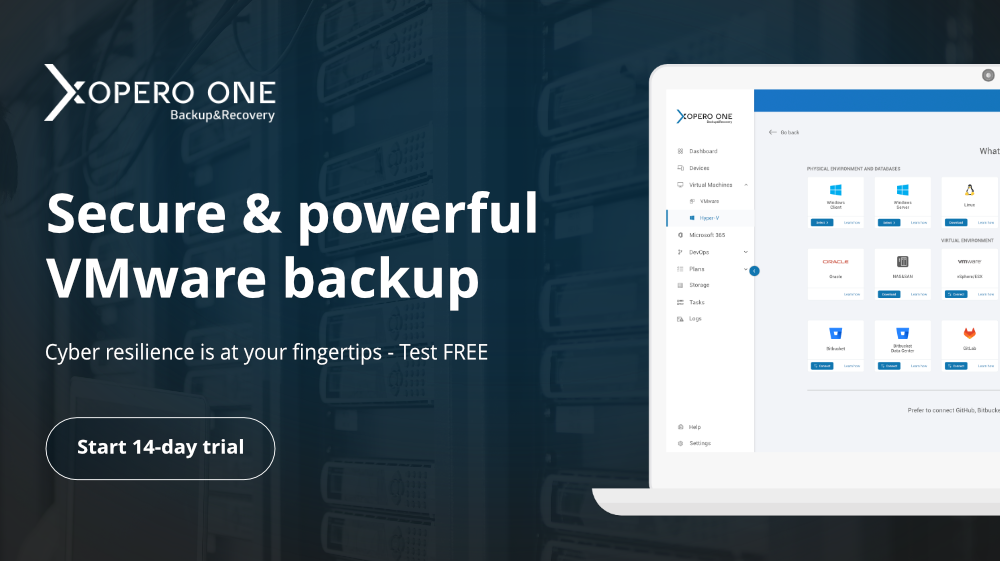Are you already familiar with VMware technology, and just want to learn more about a variety of provided features and components? Or maybe you are new to VMware virtualization and want to learn about some of the key components needed for creating a successful virtual environment? In this article, you will find information about the VMware VSphere, vCenter, and ESXi, what are those technologies’ purpose, and for what business needs they answer. We will also find differences between vSphere, ESXi, and vCenter.
The first thing to notice is that vSphere, vCenter, and ESXi are completely different technologies with completely different purposes, which makes them hard to compare. The more correct question than how they compare would be how they complement each other. But more on that later.
Let’s now take a closer look at each one of those technologies.
What is VMware ESXi?
ESXi is a type 1 hypervisor, or in other words a bare-metal hypervisor. It is a virtualization software allowing you to create multiple instances of virtual machines on one physical host. It is installed directly on your physical machine and does not require an underlying operating system to function. Due to this fact, ESXi can operate faster, be more scalable, and overall perform better than other kinds of hypervisors. But the pros of ESXi do not end here.
ESXi is one of the smallest hypervisors in the world, with a size of 150 MB. What does it mean for us? It means that the installation process of the ESXi is quick, you can also boot up the ESXi server from the USB drive, and after installation, it does not require frequent patches, and maintenance of the service is simplified. With the smaller size, and the fact that the ESXi is a bare-metal hypervisor comes greater security.
What is VMware vCenter?
VMware vCenter, actually VMware vCenter Server is a server application allowing for centralized management of the whole of your virtual infrastructure (virtual machines hosted on the ESXi instances, and the ESXi instances themselves) from a single console. This solution provides visibility, simplicity of administration and errors prevention.
VCenter Server technically speaking is not necessary for running and maintaining VMs, you can do that quite well using only ESXi. But VCenter Server brings a lot to the table, especially when you want to optimize your workflow or need centralized management. With it, administrators can configure, provision, and manage the entire VM environment from one place. Other very useful features included in VCenter Server are automation, task scheduling, and alerts features. This software will help you to optimize resource allocation and availability.
What Is VMware vSphere?
Just like Microsoft has its Office 365 platform, VMware has its vSphere. vSphere is a suite containing a huge amount of applications and features for virtualization purposes. VSphere is a virtualization platform. The most prominent parts of vSphere are VMware ESXi, VMware vCenter, about which we talked already, but also VMware vSphere Client, and many many more.
VMware vSphere’s mission is to help existing data centers switch to cloud computing, and in the process increase the utilization of the used hardware from give or take 10% to as high as 80%, without compromising the performance.
With the VSphere suite, also comes a vSphere client, which allows administrators to connect to existing ESXi servers and manage and maintain virtual machines hosted on the hypervisor.
VMware vSphere vs. vCenter vs. ESXi – how they work together
Let’s now answer the question of how these technologies complement each other, and how they work together to create a virtualization infrastructure that companies need.
To recap, vSphere is a product suite. ESXi is a hypervisor installed on the physical machine. vCenter Server is a management platform for VMs.
When you are working on a small virtualization environment, the vSphere client will be sufficient enough to maintain and manage virtual machines hosted on a few ESXi servers.
But when your environment is growing in size, and you need advanced features to manage your multiple ESXi servers, the more advanced vCenter will allow you to control access permissions, monitor performance, and for example clone an existing virtual machine. vCenter is still controlled via the vSphere client, to simplify the processes for administrators.
VMware vSphere vs. vCenter vs. ESXi – conclusions
Most physical machines are underused, working on 15% of their capacity at best, leaving 85% unused. vSphere comes with the solution to this problem, allowing us to utilize most of the hardware. On a single physical machine, multiple instances of virtual machines can be installed, running different OS and apps, your entire infrastructure can be virtualized, even if it consists of multiple connected physical machines and storage. And with that comes increased amounts of data generated, and you probably want to secure this data, even though VMs are a more secure way of keeping your data, it is not 100% bulletproof. This is why you need to have a backup of your virtual machines in place. To the rescue comes Xopero ONE VMware backup.


